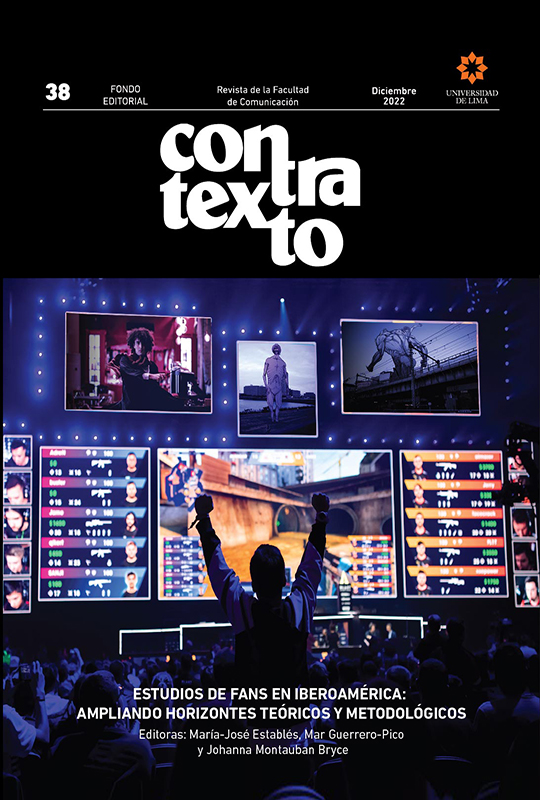Study of fan films about video games as a tool for appropriation of the official canon
DOI:
https://doi.org/10.26439/contratexto2022.n038.5869Keywords:
media convergence, participatory culture, fan films, transmedia storytelling, video gameAbstract
This research aims to fill the existing void in academic research on fan films based on video games as a transmedia expansion strategy. The objective is to analyze how video game followers apply the principles of transmedia narrative when appropriating the fictional world of video games in their fan films and whether they respect or subvert them. The methodology is descriptive and based on a content analysis of 89 films based on current video game sagas created by fans and stored in fan film repositories and on YouTube; it delves into the characters, the events, the duration, and the realism of the footage as compared to the official canon. The results demonstrate the interest in creating original experiences but respecting the interactive franchise with short films that fill in the plot gaps while expanding the game universe with new characters and events. The study reveals the professionalism behind these productions, which goes beyond isolated and amateur practices. It also establishes a profile of the prototypical audiovisual production for future studies.
Downloads
References
Abad, B. (2016). Transmedia y fenómeno fan: la co-creación en el mundo del videojuego. En J. Jiménez, I. Muguete & G. Fabián (Coords.), Historia y videojuegos: el impacto de los nuevos medios de ocio sobre el conocimiento histórico (pp. 69-104). Colección Historia y Videojuegos, 2.
Agulló, B. (2015). ¡Luces, cámara, a jugar! Videojuegos basados en películas y películas basadas en videojuegos: particularidades de la localización en diferentes escenarios. Quaderns de Cine, 10, 23-31.
Anyó, L. (2016). El jugador implicado. Videojuegos y narraciones. Laertes.
Area, M., & Pessoa, T. (2012). De lo sólido a lo líquido: las nuevas alfabetizaciones ante los cambios culturales de la Web 2.0. Comunicar, 38, 13-20. http://dx.doi.org/10.3916/C38-2012-02-01
Brookey, R. A. (2010). Hollywood gamers. Digital convergence in the film and video game industries. Indiana University Press.
Cabezas, S. G. (2020). La dimensión transmedia de Overwatch: cuando el fandom supera el canon. Indivisa: Boletín de Estudios e Investigación, 20, 259-283. https://www.lasallecentrouniversitario.es/wp-content/uploads/2020/12/11-SERGIO-GCABEZAS.pdf
Castells, M. (2006). La sociedad red: una visión global. Alianza Editorial.
Cuadrado, A., & Planells, A. J. (2020). Ficción y videojuegos. Teoría y práctica de la ludonarración. UOCPress.
Cuenca, D., & López, F. (2021). Videojuegos y procesos de transmediación. Una aproximación a los universos transmedia videolúdicos a través de la franquicia Fallout. Virtualis, 12(22), 18-30. https://www.revistavirtualis.mx/index.php/virtualis/article/view/370/430
Desarrollo Español de Videojuegos. (2022). Libro Blanco del Desarrollo Español de Videojuegos 2021. https://dev.org.es/es/publicaciones/libroblancodev2021
Despain, K. (2020). Fan films and fanworks in the age of social media: How copyright owners are relying on private ordering to avoid angering fans. BYU Law Review,2, 333-380.
Dovey, J., & Kennedy, H. W. (2006). Game cultures. Computer games as new media. Open University Press.
Espinoza, A. (2021). Fans y fanfictions, prácticas de lectura, apropiación y producción analizadas desde la estética de la recepción: el caso de Juego de tronos y Canción de hielo y fuego. Desde el Sur, 13(1), 1-30. 10.21142/DES-1301-2021-0003
Ferrés, J. (2014). Las pantallas y el cerebro emocional. Gedisa.
Frasca, G. (2003). Ludologists love stories, too. En DiGRA ’03. Proceedings of the 2003 DiGRA International Conference: Level Up (vol. 2, pp. 92-99). http://www.digra.org/wp-content/uploads/digital-library/05163.01125.pdf
Grandío, M. M. (2016). Adictos a las series. 50 años de lecciones de los fans. Editorial UOC.
Guerrero-Pico, M. (2015). Historias más allá de lo filmado: fan fiction y narrativa transmedia en series de televisión [Tesis doctoral, Universitat Pompeu Fabra]. e-Repositori upf. https://repositori.upf.edu/handle/10230/26921
Guerrero-Pico, M. (2017). #Fringe, audiences, and fan labor: Twitter activism to save a TV show from cancellation. International Journal of Communication, 11(2017), 2071-2092. https://ijoc.org/index.php/ijoc/article/view/4020
Guerrero-Pico, M., Establés, M. J., & Costa-Sánchez, C. (2022). Fan fiction y prácticas de lectoescritura transmedia en Wattpad: una exploración de las competencias narrativas y estéticas de adolescentes. Profesional de la Información, 31(2), 1-15. https://doi.org/10.3145/epi.2022.mar.12
Guerrero-Pico, M., & Scolari, C. A. (2016). Narrativas transmedia y contenidos generados por los usuarios: el caso de los crossovers. Cuadernos.info, 38, 183-200. 10.7764/cdi.38.760
Hernández, M. (2017). Manga, anime y videojuegos. Narrativa cross-media japonesa. Prensas de la Universidad de Zaragoza.
Jenkins, H. (2004). Game design as narrative architecture. En N. Wardrip-Fruin & P. Harrigan (Eds.), First person. New media as story, performance and game (pp. 117-130). The MIT Press.
Jenkins, H. (2006). Convergence Culture. La cultura de la convergencia de los medios de comunicación. Paidós Comunicación.
Jenkins, H. (2009a). The revenge of the origami unicorn: Seven principles of transmedia storytelling (Well, two actually. Five more on Friday). Confessions of an Aca-Fan: The Official Weblog of Henry Jenkins. http://henryjenkins.org/2009/12/the_revenge_of_the_origami_uni.html
Jenkins, H. (2009b). The revenge of the origami unicorn: The remaining four principles of transmedia storytelling. Confessions of an Aca-Fan: The Official Weblog of Henry Jenkins. http://henryjenkins.org/2009/12/revenge_of_the_origami_unicorn.html
Krippendorff, K. (1990). Metodología de análisis de contenido. Teoría y práctica. Paidós.
Levis, D. (1997). Los videojuegos, un fenómeno de masas. Paidós Ibérica.
Lombard, M., Snyder-Duch, J., & Bracken, C. (2002). Content analysis in mass communication: Assessment and reporting of intercoder reliability. Human Communication Research, 28(4), 587-604. https://doi.org/10.1111/j.1468-2958.2002.tb00826.x
Lozano Delmar, J., Herrero-Diz, P., Del Toro, A., & Sánchez-Martín, M. (2017). Estudio de las competencias digitales en el espectador fan español. Palabra Clave, 20(4), 917-947. 10.5294/pacla.2017.20.4.4
Martín, I. (2015). Análisis narrativo del guion de videojuego. Editorial Síntesis.
McKay, P. (2011). Culture of the future: Adapting copyright law to accommodate fan-made derivative works in the twenty-first century. Regent University Law Review, 24, 117-146.
Montero, A. (2021). Análisis audiovisual en YouTube: primera aproximación al estudio de los nuevos géneros audiovisuales interactivos. Aula Magna.
Muriel, D., & Crawford, G. (2018). Video games as culture. Considering the role and importance of video games in contemporary society. Routledge.
Navarro, V. (2012). Libertad dirigida: análisis formal del videojuego como sistema, su estructura y su avataridad [Tesis doctoral, Universitat Rovira i Virgili]. TDX. https://www.tdx.cat/handle/10803/111168#page=1
Paredes-Otero, G. (2022). Empoderamiento en la representación de los personajes femeninos de videojuegos. Obra Digital: Revista de Comunicación, 22, 81-96, https://doi.org/10.25029/od.2022.330.22
Pérez, M. A. (2015). El fan film: paradigma de la cultura participativa en el entorno de los new media [Tesis doctoral, Universidad de Sevilla]. Depósito de Investigación Universidad de Sevilla. https://idus.us.es/handle/11441/39617
Pérez Latorre, Ó. (2012). El lenguaje videolúdico. Análisis de la significación del videojuego. Laertes.
Planells, J. A. (2015). Videojuegos y mundos de ficción. De Super Mario a Portal. Cátedra.
Postigo, H. (2008). Video game appropriation through modifications. Attitudes concerning intellectual property among modders and fans. Convergence, 14(1), 59-74. 10.1177/1354856507084419
Roig, A. (2017). Películas realizadas por fans: ¿una categoría incómoda? Palabra Clave, 20(4), 979-1007. 10.5294/pacla.2017.20.4.6
Sánchez, J. J. (2005). Análisis de contenido cuantitativo de medios. En M. R. Berganza & J. A. Ruiz (Coords.), Investigar en comunicación. Guía práctica de métodos y técnicas de investigación social en Comunicación (pp. 207-228). McGraw-Hill.
Scolari, C. A. (2009). Transmedia storytelling: Implicit consumers, narrative worlds, and branding in contemporary media production. International Journal of Communication, 3(3), 586-606. https://ijoc.org/index.php/ijoc/article/view/477
Scolari, C. A. (2019). Narrativas transmedia, nuevos alfabetismos y prácticas de creación textual. Conflictos y tensiones en la nueva ecología de la comunicación. En C. A. Scolari, D. Escandell & J. A. Cordón García (Coords.), Lectoescritura digital (pp. 45-53). Ministerio de Educación y Formación Profesional.
Scolari, C. A., & Establés, M. J. (2017). El ministerio transmedia: expansiones narrativas y culturas participativas. Palabra Clave, 20(4), 1008-1041. 10.5294/pacla.2017.20.4.7
Souza-Leão, A. L. M., Moura B. M., Santana, I. R. C., Nunes, W. K. S., & Henrique, V. M. R. (2020). Fans make art: Authoring and creativity in the production of fanvideos. Revista de Negócios, 4(24), 22-36. https://www.researchgate.net/publication/348898045_Fans_Make_Art_Authoring_and_Creativity_in_the_Production_of_Fanvideos
Toffler, A. (1980). The third wave. Bantam Books.
Tushnet, R. (2017). Copyright law, fan practices, and the rights of the author. En J. Gray, C. Sandvoss & C. L. Harrington (Eds.), Fandom. Identities and communities in a mediated world (pp. 77-90). New York University Press.
Tryon, C. (2012). Fan films, adaptations, and media literacy. En J. P. Telotte & G. Duchovnay (Eds.), Science fiction film, television, and adaptation (pp. 176-190). Routledge.
Villalobos, J. M. (2014). Cine y videojuegos: un diálogo transversal. Héroes de Papel.
Walliss, J. (2010). Fan filmmaking and copyright in a global world: Warhammer 40,000 fan films and the case of Damnatus. Transformative Works and Cultures, 5. https://doi.org/10.3983/twc.2010.0178
Wolf, M. J. P. (2012). Building imaginary worlds. The theory and history of subcreation. Taylor & Francis Group.
Downloads
Published
Issue
Section
License
All of the works published are licensed under a CC BY 4.0 Creative Commons Attribution license. (updated on March 1st 2021)
The content of the journal may be shared in any material or format. The content may be adapted, contributed upon and transformed. Both possibilities are only permitted in so far as they complete the following conditions:
- Attribution: Credit must be given where it is due, a link to the license must be provided and changes, if made, must be indicated. This should be done in the manner deemed appropriate, without suggesting that the licensor promotes you or your use of the material.
Ownership rights
The patrimonial rights for Contratexto are published under a Creative Commons BY 4.0 license, allowing authors to keep the patrimonial rights to their work without restrictions.
If a work published in Contratexto were to be copied, distributed, spread, or any other activities contemplated in the aforementioned license, the author(s) and the journal must be mentioned visibly and expressly.
Self-archive
This journal allows and encourages authors to post items submitted to the journal on personal websites or institutional repositories both prior to and after publication, while providing bibliographic details that credit, if applicable, its publication in this journal.

















